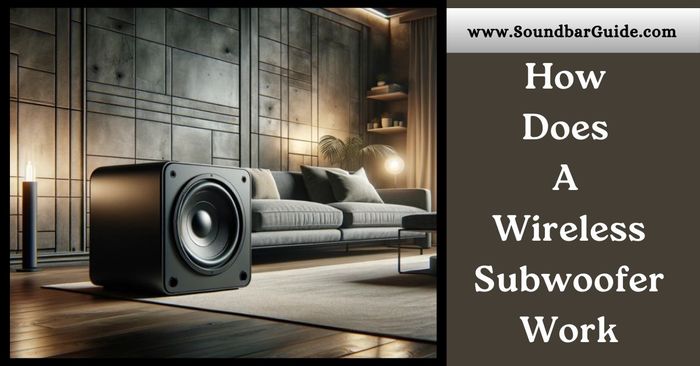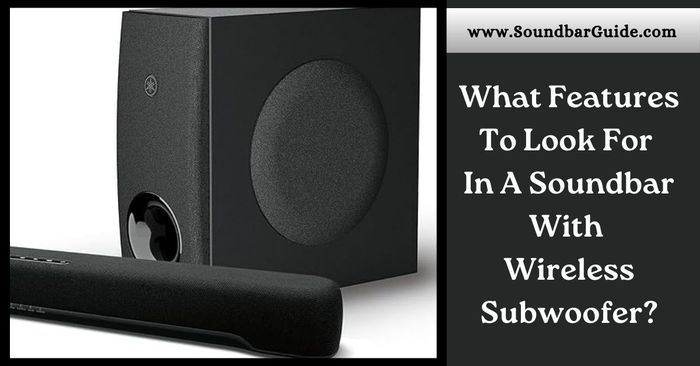Wireless subwoofers have become an essential part of home theater systems, offering the deep bass that enhances sound quality without the clutter of wires.
Whether you’re a movie buff or a music enthusiast, adding a subwoofer to your sound system elevates your listening experience by handling low-frequency sounds that standard speakers can’t reproduce.
But how does a wireless subwoofer work, and what makes it different from traditional wired models?
In this post, we’ll break down the technology behind wireless subwoofers, explain their advantages, and show you how they integrate with soundbars and other home theater systems.
So, let’s get started…
Table of Contents
What Is A Wireless Subwoofer?
A wireless subwoofer is a type of subwoofer that connects to your home audio system without the need for physical cables. While traditional subwoofers use cables to transmit audio signals, wireless subwoofers rely on radio frequencies (RF), Bluetooth subwoofer setup, or Wi-Fi to receive the signal.
The primary function of any subwoofer is to produce low-frequency sounds, or bass, which enhances everything from movie explosions to the deep beats in music.
Unlike wired subwoofers, wireless models give you the flexibility to place the subwoofer anywhere in the room, as long as it’s within range of the audio source. This flexibility eliminates clutter while still delivering the bass impact you expect from a powerful sound system.
How Does A Wireless Subwoofer Work?
A wireless subwoofer works by receiving an audio signal wirelessly from a soundbar or audio receiver. The signal transmission typically occurs over RF (radio frequency) or Bluetooth, depending on the model.
Here’s how it works:
1. Wireless Signal Transmission
The subwoofer signal transmission is sent from the soundbar or receiver to the subwoofer using wireless technology. If it’s a Bluetooth subwoofer setup, the signal is transmitted over a Bluetooth connection, while other subwoofers use RF signals. The subwoofer then processes the signal and converts it into sound, focusing on low-frequency audio.
2. Built-In Amplifier
Wireless subwoofers often come with a built-in amplifier that boosts the audio signal for the subwoofer’s driver, which is responsible for producing the bass. This setup ensures that the subwoofer delivers powerful, deep bass without distortion, enhancing the overall sound quality.
3. Power Source
While the connection to the sound system is wireless, the subwoofer still needs a power source to operate. You’ll need to plug the wireless subwoofer into a wall outlet, but the lack of an audio cable offers greater flexibility in subwoofer placement.
4. Synchronization
To ensure that the bass aligns perfectly with the rest of the audio, the subwoofer must synchronize with the soundbar or receiver. This wireless subwoofer connection ensures that all elements of the sound—highs, mids, and lows—blend seamlessly, creating an immersive listening experience.
You Can Check Out
How Does A Soundbar And Wireless Subwoofer Work Together?
A soundbar with a wireless subwoofer provides a complete audio experience by handling different parts of the sound spectrum. The soundbar typically manages mid-range and high-frequency sounds like dialogue, while the subwoofer is dedicated to low frequencies or bass.
Complementary Roles
The soundbar takes care of dialogue clarity and sound effects that operate in the mid to high frequency range, while the subwoofer produces deep bass. This combination creates a richer, fuller sound.
Wireless Pairing
When you first set up the system, you’ll need to pair the wireless subwoofer with the soundbar. Most systems have a simple “how to pair a wireless subwoofer” process that involves pressing a pairing button on both devices. Once paired, the subwoofer and soundbar communicate wirelessly to deliver a cohesive audio experience.
Seamless Integration
The beauty of using a soundbar with a wireless subwoofer is that you can place the subwoofer anywhere in the room without worrying about cords. This allows you to optimize bass distribution based on the room’s acoustics.
Advantages of Wireless Subwoofers
When comparing wireless subwoofer vs wired models, wireless subwoofers have clear advantages, especially in terms of flexibility and convenience:
No Cable Clutter
A wireless subwoofer eliminates the need for long, cumbersome cables running across your room. This makes it easier to maintain a clean, minimalist setup.
Flexible Placement
Without the restriction of wires, you can place the subwoofer wherever it sounds best, provided it’s within the wireless subwoofer range of the soundbar or receiver.
Easy Setup
Wireless subwoofers are generally easy to set up, with most models requiring only a power connection and a few pairing steps to get started. This makes them ideal for anyone looking for a hassle-free home theater upgrade.
How To Connect A Wireless Subwoofer To Soundbar?
Connecting a wireless subwoofer to your soundbar is a simple process that usually takes only a few minutes.
Most wireless subwoofer and soundbar systems are designed to automatically sync, but there are a few steps you can follow to ensure a successful connection.
Here’s how you can do it:
1. Power On the Subwoofer
First, plug the wireless subwoofer into a power outlet and turn it on. Most models will have a power button, usually located on the back or side of the unit. Ensure the power light comes on, indicating it’s ready to pair.
2. Activate Pairing Mode
Once the subwoofer is powered on, you will need to put it in pairing mode. This is usually done by pressing the “pair” or “connect” button on the subwoofer. Some models will automatically enter pairing mode when turned on.
3. Put the Soundbar in Pairing Mode
Next, turn on your soundbar and look for a similar pairing button. Press the pairing button on the soundbar, which will allow it to search for the subwoofer’s signal. Many soundbars will automatically start searching for the wireless subwoofer when turned on, especially if both devices are from the same manufacturer.
4. Wait for the Connection
After pressing the pairing buttons on both devices, give them a moment to establish a connection. You may notice an indicator light or a sound confirming that the devices have successfully paired. Some systems even display a message on your TV screen when the pairing is complete.
5. Test the Sound
Once the wireless subwoofer is connected, test the sound by playing audio through the soundbar. Adjust the subwoofer’s volume level to ensure that it complements the soundbar. You should now hear deep, rich bass that enhances the overall audio experience.
6. Troubleshooting
If the subwoofer doesn’t connect on the first try, you can:
- Turn off both the subwoofer and soundbar, then turn them back on and attempt pairing again.
- Ensure there are no obstructions between the soundbar and subwoofer, which might interfere with the wireless subwoofer connection.
- Refer to the user manual for additional instructions specific to your model.
By following these steps, you can easily pair your wireless subwoofer with a soundbar, creating a more immersive and bass-rich sound experience.
Common Technologies Used in Wireless Subwoofers
Wireless subwoofers use a variety of technologies to transmit audio signals. The most common ones are:
- Bluetooth Subwoofer Setup
Bluetooth technology is a popular choice for wireless audio systems because it’s easy to set up and works over short distances. - Radio Frequency (RF)
RF transmission provides a more stable and interference-free signal than Bluetooth, especially in larger rooms. - Wi-Fi
Some high-end wireless subwoofers connect via Wi-Fi, which can offer superior range and less interference than Bluetooth or RF.
These different technologies influence the subwoofer frequency response and overall sound quality, so it’s important to choose a subwoofer that aligns with your audio needs.
Do Wireless Subwoofers Affect Sound Quality?
The concern with wireless subwoofers is often whether they compromise on sound quality compared to wired models. The good news is that most modern wireless subwoofers deliver excellent performance, especially in home theater systems.
Key factors influencing sound quality include:
- Signal Strength
Wireless subwoofers rely on strong signal transmission to perform well. While subwoofer signal transmission can be affected by obstacles like walls, RF and Bluetooth technologies are generally reliable within a certain range. - Bass Performance
A well-designed wireless subwoofer can deliver the same punchy bass as a wired model, especially if the subwoofer frequency response is optimized for your space.
FAQs On How Does A Wireless Subwoofer Work
Does A Wireless Subwoofer Need To Be Plugged In?
Yes, a wireless subwoofer still needs to be plugged into a power outlet to function. While it connects to the sound system wirelessly for audio signals, it requires a power source to amplify the sound and produce bass.
Which Is Better Wired Or Wireless Subwoofer?
Choosing between a wired and wireless subwoofer depends on your setup and preferences. Wired subwoofers typically provide a more reliable connection and potentially better sound quality, while wireless subwoofers offer more flexibility in placement and reduce cable clutter. Ultimately, the best option is the one that suits your specific audio needs and room layout.
Can You Connect A Wireless Subwoofer To A Receiver?
Yes, you can connect a wireless subwoofer to a receiver, but it requires a compatible wireless subwoofer kit or a receiver with built-in wireless capabilities. The wireless kit typically includes a transmitter that connects to the receiver and a receiver that connects to the subwoofer, allowing for seamless audio transmission without the need for physical cables.
How Does A Wireless Subwoofer Get Power?
A wireless subwoofer gets power through a built-in power supply that connects to a standard electrical outlet. While it communicates wirelessly with the soundbar or receiver for audio signals, it requires a wired connection for power to operate effectively. This setup allows for flexible placement without the clutter of audio cables.
What Is The Best Soundbar With Wireless Subwoofer?
The Sony HT-S400 is one of the best rated soundbars with a wireless subwoofer, offering an impressive audio experience with deep bass and clear dialogue. Its user-friendly setup, sleek design, and compatibility with various devices make it a top choice for enhancing your home theater setup. With features like Bluetooth connectivity, it’s perfect for streaming music and enjoying your favorite shows.
Can I Use A Wireless Subwoofer With Any Sound System?
No, you cannot use a wireless subwoofer with any sound system. Wireless subwoofers are typically designed to work with specific sound systems or brands that support wireless connectivity, often requiring a compatible transmitter or receiver to function properly. Always check the compatibility of the subwoofer with your existing sound system before purchasing.
Where To Place My Wireless Subwoofer With Soundbar?
For optimal performance, place your wireless subwoofer in a corner or against a wall, as this helps amplify the bass. Ideally, position it within a few feet of the soundbar for seamless connectivity, ensuring it’s not obstructed by furniture. Experimenting with different locations can also enhance sound quality, so feel free to adjust until you find the best spot.
Conclusion
A wireless subwoofer is an excellent addition to any home theater system, offering powerful bass without the hassle of cables. Understanding how a wireless subwoofer works and how it integrates with your sound system allows you to make the most of this technology.
With easy setup, flexible placement, and high-quality sound, wireless subwoofers are an attractive option for enhancing your home audio experience.
Whether you’re setting up a new soundbar system or upgrading your home theater, a wireless subwoofer is a smart choice that combines convenience and performance.
If you like this post, you can share with your audiophile friends. Also, you can share your personal thoughts on wireless soundbars in the comment section below.
Lastly, you can FOLLOW our blog to get updated tips and tutorials on soundbars and similar gadgets.


![How To Connect Vizio Soundbar To Vizio TV: [Step By Step Guide]](https://soundbarguide.com/wp-content/uploads/2024/10/how-to-connect-vizio-soundbar-to-vizio-tv.jpg)


Leave a Reply